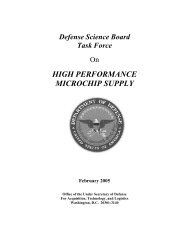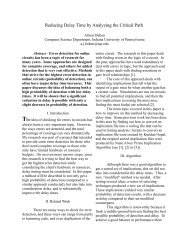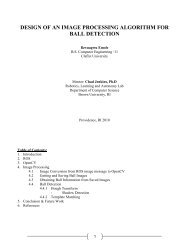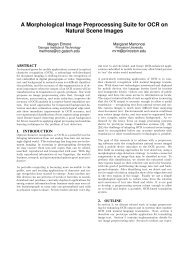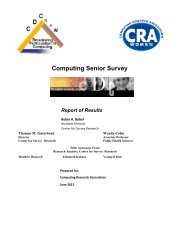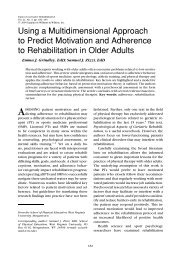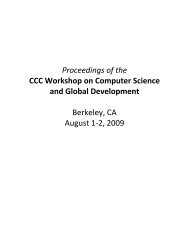A National Initiative in Emergency Informatics - Computing Research ...
A National Initiative in Emergency Informatics - Computing Research ...
A National Initiative in Emergency Informatics - Computing Research ...
Create successful ePaper yourself
Turn your PDF publications into a flip-book with our unique Google optimized e-Paper software.
A <strong>National</strong> <strong>Initiative</strong> <strong>in</strong> <strong>Emergency</strong> <strong>Informatics</strong><br />
Rob<strong>in</strong> R. Murphy<br />
Texas A&M University<br />
Comput<strong>in</strong>g Community Consortium<br />
Version 1: November 3, 2010 1<br />
!<br />
Figure 1. Examples of emerg<strong>in</strong>g <strong>in</strong>formation technologies expected to revolutionize disaster management as an <strong>in</strong>formation<br />
process. (Photo from 2007 Berkman Plaza II collapse, Jacksonville, Florida.)<br />
<strong>Emergency</strong> <strong>in</strong>formatics is an emerg<strong>in</strong>g <strong>in</strong>terdiscipl<strong>in</strong>ary, socio-technical field that<br />
addresses the <strong>in</strong>formation processes (real-time collection, analysis, distribution, and<br />
visualization) for prevention, preparedness, response and recovery from emergencies.<br />
Emergencies span a large range from rout<strong>in</strong>e local emergencies, where “smart”<br />
ambulances are beg<strong>in</strong>n<strong>in</strong>g to facilitate victim management, to large-scale, <strong>in</strong>frequent<br />
events such as disasters, where advances <strong>in</strong> unmanned systems, wireless networks,<br />
comput<strong>in</strong>g, social network<strong>in</strong>g, and other <strong>in</strong>formation technologies (see Figure 1) could<br />
revolutionize response and recovery by provid<strong>in</strong>g novel, richer ways to collect, transmit,<br />
and use data. <strong>Emergency</strong> <strong>in</strong>formatics expands the notion of a socio-technical system<br />
beyond people <strong>in</strong>teract<strong>in</strong>g with technical systems (visualizations, simulations, planners),<br />
to people <strong>in</strong>teract<strong>in</strong>g with people through technical systems (wireless networks, cloud<br />
comput<strong>in</strong>g, social comput<strong>in</strong>g), and people <strong>in</strong>teract<strong>in</strong>g with remote environments through<br />
technical systems (unmanned systems, sensor networks) – all to accomplish the mission<br />
of reduc<strong>in</strong>g deaths, accelerat<strong>in</strong>g damage assessment, and m<strong>in</strong>imiz<strong>in</strong>g economic<br />
downtime.<br />
As highlighted by the White House’s <strong>National</strong> Science and Technology Council 2 and the<br />
Comput<strong>in</strong>g <strong>Research</strong> Association, 3 emergency <strong>in</strong>formatics is a “Grand Challenge”<br />
!!!!!!!!!!!!!!!!!!!!!!!!!!!!!!!!!!!!!!!!!!!!!!!!!!!!!!!!<br />
1 Contact: Erw<strong>in</strong> Gianchandani, Director, Comput<strong>in</strong>g Community Consortium (202-266-2936;<br />
erw<strong>in</strong>@cra.org). For the most recent version of this essay, as well as related essays, visit<br />
http://www.cra.org/ccc/<strong>in</strong>itiatives.<br />
2 Committee on Environment and Natural Resources. Grand Challenges for Disaster Reduction. (2008).<br />
<strong>National</strong> Science and Technology Council. Executive Office of the President.<br />
3<br />
Comput<strong>in</strong>g <strong>Research</strong> Association. Grand <strong>Research</strong> Challenges <strong>in</strong> Information Systems. (2003).<br />
Wash<strong>in</strong>gton, DC.
problem due to the range of geographical scales, the temporal constra<strong>in</strong>ts, the complexity<br />
of <strong>in</strong>teractions between agencies and the public, and the impact on life and the quality of<br />
life. From a mathematical viewpo<strong>in</strong>t, emergency <strong>in</strong>formatics is what DeGrace and Stahl<br />
def<strong>in</strong>e as a wicked problem 4 with large <strong>in</strong>terdependencies, multiple temporal and spatial<br />
scales that exhibit nonl<strong>in</strong>ear behavior, and no s<strong>in</strong>gle optimal solution. Therefore, the<br />
<strong>in</strong>formation technologies that were successful <strong>in</strong> mitigat<strong>in</strong>g one disaster would not<br />
necessarily be as effective <strong>in</strong> another.<br />
<strong>Emergency</strong> impacts <strong>in</strong>clude death or reduced quality of life from <strong>in</strong>jury, disruptions of<br />
the critical <strong>in</strong>frastructure, and economic downtime. Deaths and <strong>in</strong>jury are obvious<br />
outcomes of a disaster, with over 1,200 deaths reported <strong>in</strong> Hurricane Katr<strong>in</strong>a, 230,000 <strong>in</strong><br />
the Haiti earthquake, and 1,100 <strong>in</strong> the recent (summer 2010) flood<strong>in</strong>g <strong>in</strong> Pakistan. But<br />
more subtle and pervasive are the impacts to critical <strong>in</strong>frastructure as well as overall<br />
social vulnerability. Delays <strong>in</strong> damage assessment to bridges, roads, pipel<strong>in</strong>es, hospitals<br />
and schools can prevent rapid evacuation and shelter<strong>in</strong>g (such as after an earthquake), reentry<br />
(after a hurricane), and mitigation of leak<strong>in</strong>g pollutants. These have an obvious<br />
impact on productivity and economic recovery (estimated at $150 billion for Hurricane<br />
Katr<strong>in</strong>a) but there is also a more subtle impact on <strong>in</strong>dividuals, whose losses are usually<br />
not <strong>in</strong>cluded <strong>in</strong> assessments of recovery costs. Consider, for example, that the average<br />
daily cost to a Galveston, TX, household that evacuated due to Hurricane Ike was $150<br />
per day. The average number of days before the family could return was 29 days, so the<br />
family’s total evacuation cost was $4,350. But the average monthly salary of an<br />
evacuated family was $5,066, mean<strong>in</strong>g that the family essentially lost two months, not<br />
one, of <strong>in</strong>come! Moreover, the impact on <strong>in</strong>dividuals was actually far worse because the<br />
homeowners could not start the <strong>in</strong>surance process or repairs until the <strong>in</strong>frastructure was<br />
sufficiently rehabilitated to permit them to return home, and even m<strong>in</strong>or damage to<br />
structures was <strong>in</strong>tensified by unchecked exposure for a month to the elements. Small<br />
bus<strong>in</strong>esses are also impacted by delays <strong>in</strong> re-entry. For example, dur<strong>in</strong>g Ike, until reentry,<br />
they could not obta<strong>in</strong> the<br />
verification of damage assessment<br />
needed to start the small bus<strong>in</strong>ess<br />
recovery loan process.<br />
The importance to life, the<br />
economy, and the environment<br />
comb<strong>in</strong>ed with the <strong>in</strong>tellectual<br />
challenge of emergency<br />
<strong>in</strong>formatics argues that this field<br />
should be recognized and treated<br />
as a dist<strong>in</strong>ct area of <strong>in</strong>quiry.<br />
Figure 2. Availability versus Impact of emergency <strong>in</strong>formation over time.<br />
Heuristic derived from the State of Florida <strong>Emergency</strong> Response Team’s<br />
experiences with over a dozen major hurricanes and state-wide wildfires<br />
s<strong>in</strong>ce 1992.<br />
!!!!!!!!!!!!!!!!!!!!!!!!!!!!!!!!!!!!!!!!!!!!!!!!!!!!!!!!<br />
4 DeGrace, Peter & Stahl, Hulet L. (1998). Wicked Problems, Righteous Solutions: A Catalog of Modern<br />
Eng<strong>in</strong>eer<strong>in</strong>g Paradigms. Prentice Hall PTR. 1st edition. 12 February.
Information availability and <strong>in</strong>formation impact are currently misaligned.<br />
An empirical analysis of the impact and availability of <strong>in</strong>formation dur<strong>in</strong>g emergencies<br />
(see Figure 2) shows that impact and availability are currently totally misaligned. That is,<br />
when <strong>in</strong>formation can have its greatest impact, it is not available; by the time this<br />
<strong>in</strong>formation becomes available, it has almost no impact. As shown by the two lognormal<br />
curves <strong>in</strong> Figure 2, data are currently not available (either they do not exist or<br />
they are not visible to the decision maker) when they are needed the most, particularly <strong>in</strong><br />
the first 72 hours follow<strong>in</strong>g a disaster when key resource allocation (responders, doctors,<br />
food, water, etc.) and deployment (how many, where) decisions are made. 5 Information is<br />
needed to direct rescuers to the clusters of probable survivors and to optimize general<br />
relief and recovery operations.<br />
Small advances <strong>in</strong> emergency <strong>in</strong>formatics could significantly reduce deaths,<br />
accelerate damage assessment, and m<strong>in</strong>imize economic downtime.<br />
<strong>Emergency</strong> <strong>in</strong>formatics could significantly move the <strong>in</strong>formation availability curve <strong>in</strong><br />
Figure 2 closer to the impact curve <strong>in</strong> two ways. Better <strong>in</strong>itial projections of damage and<br />
of social and environmental vulnerability could be provided through more advanced<br />
simulations and probabilistic algorithms as well as deployment of embedded sensors and<br />
sensor networks prior to an emergency – and through improved access to the result<strong>in</strong>g<br />
data streams through the web. Real-time observations could be provided by unmanned<br />
systems, sensor networks, or<br />
redirected sources (such as<br />
traffic cameras) connected by<br />
faster, higher capacity<br />
networks, as well as through<br />
crowd sourc<strong>in</strong>g.<br />
Figure 3 shows that a small<br />
change <strong>in</strong> the <strong>in</strong>formation<br />
curve might lead to cutt<strong>in</strong>g<br />
deaths and economic<br />
downtime <strong>in</strong> half. For<br />
example, <strong>in</strong>creas<strong>in</strong>g the<br />
accuracy of an <strong>in</strong>itial<br />
projection of the location and<br />
extent of physical damage to<br />
just 40% of the true state<br />
Figure 3. Shift <strong>in</strong> Information Availability curve to the left and doubl<strong>in</strong>g of<br />
contribution (bright green) due to 40% <strong>in</strong>crease <strong>in</strong> <strong>in</strong>itial <strong>in</strong>formation<br />
(orange diamond) and reach<strong>in</strong>g 80% of maximum with<strong>in</strong> 48 hours (yellow<br />
diamond).<br />
would both better <strong>in</strong>form responders on where to search for victims and bootstrap the<br />
recovery process. Accelerat<strong>in</strong>g the po<strong>in</strong>t at which most (80%) of the <strong>in</strong>formation is<br />
available from 72 hours to 48 hours through observations and network<strong>in</strong>g would further<br />
!!!!!!!!!!!!!!!!!!!!!!!!!!!!!!!!!!!!!!!!!!!!!!!!!!!!!!!!<br />
5 Rao, Ramesh R. & Schmitt, J.E. & Ted, Editors. Committee on Us<strong>in</strong>g Information Technology to<br />
Enhance Disaster Management. <strong>National</strong> <strong>Research</strong> Council, Improv<strong>in</strong>g Disaster Management: The Role of<br />
IT <strong>in</strong> Mitigation, Preparedness, Response, and Recovery. (2007). Computer Science and<br />
Telecommunications Board (CSTB) and E.A.P.S. (DEPS), Editors.
<strong>in</strong>crease their effectiveness. Together, these two changes would shift the <strong>in</strong>formation<br />
curve upward and to the left. If the area under the curves represents the contribution of<br />
the <strong>in</strong>formation to the response, then the shift <strong>in</strong> the availability curve would double the<br />
area—suggest<strong>in</strong>g a doubl<strong>in</strong>g <strong>in</strong> contribution. Optimistically, this doubl<strong>in</strong>g would<br />
correspond to a halv<strong>in</strong>g of outcomes. In other words, were this small shift <strong>in</strong> <strong>in</strong>formation<br />
availability <strong>in</strong> place prior to Hurricane Katr<strong>in</strong>a and the Haiti earthquakes, it could have<br />
reduced the deaths <strong>in</strong> Katr<strong>in</strong>a from 1,200 to 600 and Haiti from 230,000 to 115,000, as<br />
well as the economic consequences from $150 billion to $75 billion for Katr<strong>in</strong>a alone.<br />
A systems approach to research and development that encompasses both policydirected<br />
and socially-directed <strong>in</strong>formation technologies to address the barriers of<br />
poor access to the site and the lack of coord<strong>in</strong>ation among stakeholders is needed.<br />
Achiev<strong>in</strong>g the advances motivat<strong>in</strong>g Figure 3 is not trivial. A systems approach is needed<br />
to overcome the two categories of barriers unique to emergency <strong>in</strong>formatics: lack of<br />
access to the disaster site by decision makers and lack of coord<strong>in</strong>ation among multiple<br />
organizations <strong>in</strong>dependently mak<strong>in</strong>g decisions with hidden dependencies (i.e., emergency<br />
response is what Nobel laureate Ostrom describes as a polycentric control architecture. 6 )<br />
It must <strong>in</strong>tegrate policy-directed <strong>in</strong>formation technology under the direct control of crisis<br />
management teams (e.g., UAVs, structural damage projections, secure wireless networks,<br />
etc.) with socially-directed <strong>in</strong>formation technology (e.g., crowd sourc<strong>in</strong>g, participatory<br />
sens<strong>in</strong>g, social network<strong>in</strong>g, etc.). As noted <strong>in</strong> Improv<strong>in</strong>g Disaster Management, 2 victims<br />
and the public also play major, proactive, but ad hoc, roles <strong>in</strong> the disaster response and<br />
recovery, yet these roles are not well understood but must be facilitated to build resilient<br />
communities.<br />
These socially-directed <strong>in</strong>formation technologies are unlikely to be adopted by policydirected<br />
agencies without advances <strong>in</strong> directability and trustworth<strong>in</strong>ess.<br />
Fourteen studies s<strong>in</strong>ce 2003 by the President’s Council of Advisors on Science and<br />
Technology (PCAST), 7,8 <strong>National</strong> Science and Technology Council, 2 <strong>National</strong><br />
Academies, 5,9,10,11,12,13,14,15 and Defense Science Board 16,17,18 have concluded that success<br />
!!!!!!!!!!!!!!!!!!!!!!!!!!!!!!!!!!!!!!!!!!!!!!!!!!!!!!!!<br />
6<br />
Andersson, K.P. & E. Ostrom, Analyz<strong>in</strong>g decentralized resource regimes from a polycentric perspective.<br />
Policy Science, 2008. 41: p. 71-93.<br />
7 President's Council of Advisors on Science and Technology. The Science and Technology of Combatt<strong>in</strong>g<br />
Terrorism. (2003). Office of Science and Technology Policy. Executive Office of the President.<br />
8 President's Council of Advisors on Science and Technology. NIT for Resilient Physical Systems. (2007).<br />
President's Council of Advisors on Science and Technology. Executive Office of the President.<br />
9 Committee on Plann<strong>in</strong>g for Catastrophe: A Bluepr<strong>in</strong>t for Improv<strong>in</strong>g Geospatial Data, Tools, and<br />
Infrastructure, Successful Response Starts with a Map: Improv<strong>in</strong>g Geospatial Support for Disaster<br />
Management. (2007). Board on Earth Sciences and Resources (BESR) and E.a.L.S. (DELS), Editors. The<br />
<strong>National</strong> Academies Press.<br />
10 Committee on the Future of <strong>Emergency</strong> Care <strong>in</strong> the United States Health System, <strong>Emergency</strong> Medical<br />
Services: At the Crossroads. (2007). Board on Health Care Services (HCS) and I.o.M. (IOM), Editors. The<br />
<strong>National</strong> Academies Press.
<strong>in</strong> emergency <strong>in</strong>formatics will not be found <strong>in</strong> component technologies, manpower, or<br />
physical resources by themselves. Rather, each study has found that success will come<br />
from systems approaches to develop<strong>in</strong>g the <strong>in</strong>formation for timely decision mak<strong>in</strong>g,<br />
synchroniz<strong>in</strong>g the flow of this <strong>in</strong>formation to the shift<strong>in</strong>g demands of disasters, and<br />
general socio-technical aspects of the <strong>in</strong>formatics process.<br />
The needed research and development spans many exist<strong>in</strong>g topics <strong>in</strong> comput<strong>in</strong>g.<br />
<strong>Emergency</strong> <strong>in</strong>formatics research and development must <strong>in</strong>tegrate advances <strong>in</strong> key areas<br />
and ultimately <strong>in</strong>volves multi-discipl<strong>in</strong>ary efforts. Cyber-physical systems, especially<br />
unmanned systems such as aerial vehicles, are be<strong>in</strong>g used to collect new types of data and<br />
at larger scales than ever before. New sensors, coord<strong>in</strong>ation mechanisms for sensor<br />
networks, and sens<strong>in</strong>g algorithms for process<strong>in</strong>g and fus<strong>in</strong>g asynchronous sensor data are<br />
matur<strong>in</strong>g. Investments <strong>in</strong> wireless and physical network research <strong>in</strong>itiated after the World<br />
Trade Center collapse are pay<strong>in</strong>g off. The Internet 2-based Next Generation 911 system<br />
will harden connections to 911 call centers <strong>in</strong> each county <strong>in</strong> the US and support easy<br />
connections to responders’ wireless LANs. Phone companies have created mobile cell<br />
towers, allow<strong>in</strong>g communications to be re-established with<strong>in</strong> hours of Hurricane Ike and<br />
with<strong>in</strong> a day upon gett<strong>in</strong>g access to Haiti. However, the <strong>in</strong>creas<strong>in</strong>g availability of sensor<br />
data pushes the envelope on current network<strong>in</strong>g technology and requires new approaches<br />
to guarantee<strong>in</strong>g quality of service, given that more comput<strong>in</strong>g will be done <strong>in</strong> the Cloud<br />
but network connectivity may be <strong>in</strong>terrupted – particularly dur<strong>in</strong>g emergencies. In<br />
addition, different users will have different priorities for the data. Advances <strong>in</strong> comput<strong>in</strong>g<br />
are needed to support human decision-mak<strong>in</strong>g, <strong>in</strong>clud<strong>in</strong>g generation of predictive<br />
simulation techniques (such as the capability to compare real-time <strong>in</strong>formation to prior<br />
models of the environment or situation) and visualization mechanisms, as well as use of<br />
!!!!!!!!!!!!!!!!!!!!!!!!!!!!!!!!!!!!!!!!!!!!!!!!!!!!!!!!<br />
11 <strong>National</strong> <strong>Research</strong> Council. Citizen Engagement <strong>in</strong> <strong>Emergency</strong> Plann<strong>in</strong>g for a Flu Pandemic: A<br />
Summary of the October 23, 2006 Workshop of the Disasters Roundtable. (2007). Disasters Roundtable<br />
(DR) and E.a.L.S. (DELS), Editors. The <strong>National</strong> Academies Press.<br />
12 Committee on the Effective Use of Data, Methodologies, and Technologies to Estimate Sub national<br />
Populations at Risk, <strong>National</strong> <strong>Research</strong> Council. (2007). Tools and Methods for Estimat<strong>in</strong>g Populations at<br />
Risk from Natural Disasters and Complex Humanitarian Crises. Board on Earth Sciences and Resources<br />
(BESR), et al., Editors. The <strong>National</strong> Academies Press.<br />
13 Kershaw, Patricia Jones & Mason, Byron E. <strong>National</strong> <strong>Research</strong> Council, The Indian Ocean Tsunami<br />
Disaster: Implications for U.S. and Global Disaster Reduction and Preparedness- Summary of the June 21,<br />
2005 Workshop of the Disasters Roundtable. (2006). Disasters Roundtable (DR) and E.a.L.S. (DELS),<br />
Editors. The <strong>National</strong> Academies Press.<br />
14 Mason, Byron E. <strong>National</strong> <strong>Research</strong> Council, Community Disaster Resilience: A Summary of the March<br />
20, 2006 Workshop of the Disasters Roundtable. (2006). Disasters Roundtable (DR) and E.a.L.S. (DELS),<br />
Editors. The <strong>National</strong> Academies Press.<br />
15 Committee on Disaster <strong>Research</strong> <strong>in</strong> the Social Sciences: Future Challenges and Opportunities, <strong>National</strong><br />
<strong>Research</strong> Council, Fac<strong>in</strong>g Hazards and Disasters: Understand<strong>in</strong>g Human Dimensions. (2006). E.a.L.S.<br />
(DELS), Editor. The <strong>National</strong> Academies Press.<br />
16 DSB Task Force on Future Perspectives, Defense Imperatives for the New Adm<strong>in</strong>istration. (2008).<br />
Defense Science Board.<br />
17 DSB Task Force on Critical Homeland Infrastructure Protection, Critical Homeland Infrastructure<br />
Protection. (2007). Defense Science Board.<br />
18 DSB Task Force on DoD Roles and Missions <strong>in</strong> Homeland Security. (2003). DoD Roles and Missions <strong>in</strong><br />
Homeland Security. Defense Science Board.
games for tra<strong>in</strong><strong>in</strong>g. Progress <strong>in</strong> facilitat<strong>in</strong>g human decision-mak<strong>in</strong>g requires concurrent<br />
effort <strong>in</strong> established areas of comput<strong>in</strong>g: human-centered comput<strong>in</strong>g, real-time and<br />
distributed comput<strong>in</strong>g (<strong>in</strong>clud<strong>in</strong>g optimization), security, and artificial <strong>in</strong>telligence for<br />
plann<strong>in</strong>g and resource allocation. Social comput<strong>in</strong>g, such as seen at the Haiti earthquake,<br />
is another critical topic captur<strong>in</strong>g the range of crowd sourc<strong>in</strong>g, social network<strong>in</strong>g, and<br />
participatory sens<strong>in</strong>g.<br />
It is critically important that research and development efforts br<strong>in</strong>g together these pieces<br />
or themes <strong>in</strong> a way that produces measurable improvements <strong>in</strong> coord<strong>in</strong>ation,<br />
synchronization, resilience, and trustworth<strong>in</strong>ess throughout the life cycle of emergency<br />
prevention, preparedness, response, and recovery. Ultimately, the driv<strong>in</strong>g metric is the<br />
time it takes for “centers” of response to have the best <strong>in</strong>formation to make the most<br />
adaptive decisions that best satisfy all of the <strong>in</strong>terdependencies and all of the goals of the<br />
different stakeholders and participants.<br />
Federally sponsored research and development is essential as the emergency<br />
<strong>in</strong>formatics market is high risk, doma<strong>in</strong> knowledge is esoteric, and testbeds are<br />
almost non-existent.<br />
Industrial research and development <strong>in</strong> emergency <strong>in</strong>formatics is unlikely to be driven by<br />
market forces or “natural” alliances and thus poses high risk. The adoption model for<br />
public sector technologies is different from the consumer market and cannot fully<br />
leverage <strong>in</strong>novations from the Department of Defense (DoD). The public sector model is<br />
low-volume, low-profit marg<strong>in</strong>, with requirements set forth from the bottom up and with<br />
multiple acquisition centers (e.g., fire and police departments, emergency operations<br />
centers, etc.). In contrast, consumer <strong>in</strong>formation technology is high-volume, high-profit,<br />
with <strong>in</strong>dividuals usually acquir<strong>in</strong>g it. Meantime, Defense technology is specified and<br />
acquired from a central source with high profit marg<strong>in</strong>s on low-volume devices. Even<br />
when Defense <strong>in</strong>formation technology closely fits a given emergency response need, the<br />
tra<strong>in</strong><strong>in</strong>g and ma<strong>in</strong>tenance associated with the technology often exceeds what can be<br />
supported by a public agency.<br />
Academic research and development has a wealth of transformative ideas but is similarly<br />
unlikely to directly address emergency <strong>in</strong>formatics by itself, because of lack of doma<strong>in</strong><br />
knowledge and high-fidelity testbeds (which often require capital <strong>in</strong>vestments on the<br />
order of high-performance comput<strong>in</strong>g or nanotechnology, putt<strong>in</strong>g them beyond the means<br />
of universities’ <strong>in</strong>ternal funds). As noted earlier, the systems approach to emergency<br />
<strong>in</strong>formatics requires large multi-discipl<strong>in</strong>ary teams, but <strong>in</strong> general, multi-discipl<strong>in</strong>ary<br />
team projects have limited fund<strong>in</strong>g opportunities and are highly competitive. Even if<br />
highly motivated, researchers lack doma<strong>in</strong> knowledge and access to users to focus on the<br />
most productive research questions and field conditions <strong>in</strong> which to test their <strong>in</strong>novations.<br />
The two barriers to engag<strong>in</strong>g <strong>in</strong>dustry and academia described above illustrate why<br />
Federal support is critical to pave the way for <strong>in</strong>novation <strong>in</strong> emergency <strong>in</strong>formatics<br />
through academic research and <strong>in</strong>dustrial development. There is no natural,<br />
significant source of fund<strong>in</strong>g for academic research <strong>in</strong> emergency <strong>in</strong>formatics, as
emergency <strong>in</strong>formatics is expensive, rely<strong>in</strong>g on large multi-discipl<strong>in</strong>ary teams, and<br />
constitutes a new type of research requir<strong>in</strong>g partner<strong>in</strong>g with stakeholders – none of which<br />
is supported by traditional research fund<strong>in</strong>g sources (with the exception of a few special<br />
programs).<br />
Development fund<strong>in</strong>g for <strong>in</strong>dustry is needed <strong>in</strong> two areas. One pool of fund<strong>in</strong>g is<br />
necessary to enable agencies to purchase technologies, creat<strong>in</strong>g the customer “pull” that<br />
will reactively drive U.S. bus<strong>in</strong>ess <strong>in</strong>novation. For example, the Department of Justice<br />
created a grant program to allow bomb squads to purchase IED robots, which <strong>in</strong> turn<br />
accelerated the development of new sensors and <strong>in</strong>terfaces essential for law enforcement<br />
but not required for DoD applications. Second, a pool of fund<strong>in</strong>g for small bus<strong>in</strong>ess<br />
grants, especially Small Bus<strong>in</strong>ess Technology Transfer (STTR) which encourages<br />
<strong>in</strong>dustry-academia team<strong>in</strong>g, would allow U.S. bus<strong>in</strong>esses to bootstrap <strong>in</strong>novation and<br />
establish a proactive cycle of new technologies.<br />
Susta<strong>in</strong>ed, visible research fund<strong>in</strong>g is also needed to enable the formation of multidiscipl<strong>in</strong>ary<br />
academic teams and to create the necessary testbeds that will drive work by<br />
these teams. The size of the academic teams comb<strong>in</strong>ed with the need for partner<strong>in</strong>g with<br />
emergency professionals and <strong>in</strong>dustry constitute challenges typically handled by a Center<br />
of Excellence Program or Eng<strong>in</strong>eer<strong>in</strong>g <strong>Research</strong> Center on the order of $10-20M for five<br />
years, renewable for another five. Unfortunately, agencies award perhaps one or at most<br />
three <strong>in</strong> a particular topic and do not revisit the topic for years. In order to have the k<strong>in</strong>d<br />
of impact warranted by such a topic of national <strong>in</strong>terest, an alternative strategy is to<br />
establish a network of 10 research/practitioner centers, each on the order of $10M over<br />
four years and tasked with a different facet of the emergency <strong>in</strong>formatics<br />
problem/research space def<strong>in</strong>ed above, and ideally one per FEMA region. These centers<br />
would seed the creation of the emergency <strong>in</strong>formatics research community and establish a<br />
culture of university-stakeholder partnerships. A major research <strong>in</strong>strumentation<br />
program creat<strong>in</strong>g testbeds housed at regional fire or law enforcement tra<strong>in</strong><strong>in</strong>g<br />
academies, on the order of $90M, 19 would also have multiple benefits. It would provide<br />
researchers with scale testbeds while <strong>in</strong>centiviz<strong>in</strong>g the creation of academic/agency<br />
partnerships, and it would give emergency response agencies ownership of advanced<br />
comput<strong>in</strong>g resources such as wireless <strong>in</strong>strumentation, servers, RFID tags, unattended<br />
sensors, unmanned systems, etc., which should lead to stakeholder <strong>in</strong>novation and a<br />
stakeholder “push” for research.<br />
Advances <strong>in</strong> research and development require the transformation of comput<strong>in</strong>g<br />
education to both empower discovery and to create an <strong>in</strong>formed scientific and<br />
practitioner base.<br />
Academic research <strong>in</strong> emergency <strong>in</strong>formatics suffers from engag<strong>in</strong>g practitioners late <strong>in</strong><br />
the R&D cycle, perpetuat<strong>in</strong>g cohorts of graduates with little or no hands-on (i.e., “<strong>in</strong> the<br />
field”) expertise. Cont<strong>in</strong>u<strong>in</strong>g to promote the l<strong>in</strong>ear sequence of development misses<br />
opportunities for cross-fertilization, makes transfer of R&D results too slow and<br />
!!!!!!!!!!!!!!!!!!!!!!!!!!!!!!!!!!!!!!!!!!!!!!!!!!!!!!!!<br />
19 The annual budget for the acquisition grants with the <strong>National</strong> Science Foundation’s (NSF’s) Major<br />
<strong>Research</strong> Instrumentation (MRI) program: http://www.nsf.gov/fund<strong>in</strong>g/pgm_summ.jsp?pims_id=5260.
happenstance, and <strong>in</strong>creases the risk that projects will be sterile. Educational<br />
methodologies that emphasize the engagement of stakeholders <strong>in</strong> the design process and<br />
ground research with field-test<strong>in</strong>g experiences are essential to creat<strong>in</strong>g <strong>in</strong>novative<br />
knowledge workers <strong>in</strong> emergency <strong>in</strong>formatics.<br />
At the same time, emergency professionals require tra<strong>in</strong><strong>in</strong>g <strong>in</strong> order to more rapidly and<br />
effectively adopt <strong>in</strong>novations. Thus, advances <strong>in</strong> comput<strong>in</strong>g and <strong>in</strong>formation technologies<br />
such as onl<strong>in</strong>e education methods and serious games for tra<strong>in</strong><strong>in</strong>g are critical to support<br />
the educational demand of emergency <strong>in</strong>formatics.<br />
Because <strong>in</strong>dividual <strong>in</strong>formation technologies already exist, a well-funded <strong>in</strong>itiative<br />
on emergency <strong>in</strong>formatics could significantly improve disaster response with<strong>in</strong> five<br />
years and create a new sector of the economy.<br />
As shown <strong>in</strong> Figure 3, even modest advancements <strong>in</strong> <strong>in</strong>formatics could significantly<br />
reduce deaths, accelerate damage assessment, and m<strong>in</strong>imize economic downtime. Given<br />
that much of the core technology exists, there is “low-hang<strong>in</strong>g fruit.” For example, a<br />
hardened Next Generation 9-1-1 network that will connect all emergency operations<br />
centers <strong>in</strong> the U.S. is currently be<strong>in</strong>g <strong>in</strong>stalled. It has a place <strong>in</strong> the protocol for<br />
prioritiz<strong>in</strong>g data transmission to different users, but at this time, no algorithm exists to<br />
handle the rout<strong>in</strong>g. A national focus on emergency <strong>in</strong>formatics would connect the<br />
resource allocation and network<strong>in</strong>g communities with the users and fill precisely these<br />
types of gaps.<br />
A comprehensive and unified understand<strong>in</strong>g of emergency <strong>in</strong>formatics would help reduce<br />
the risk to companies <strong>in</strong>terested <strong>in</strong> migrat<strong>in</strong>g exist<strong>in</strong>g technologies or <strong>in</strong>novat<strong>in</strong>g new<br />
solutions. While there is no means of estimat<strong>in</strong>g the emergency <strong>in</strong>formatics market, the<br />
potential for one aspect – small UAVs for respond<strong>in</strong>g to wildfires and other emergencies<br />
– is expected to be over $7 billion annually, and these devices will create a need for<br />
network<strong>in</strong>g <strong>in</strong>frastructures, allocation software, visualizations, and software eng<strong>in</strong>eer<strong>in</strong>g<br />
<strong>in</strong>dustries.<br />
With susta<strong>in</strong>ed and coord<strong>in</strong>ated fund<strong>in</strong>g through agencies such the Department of<br />
Homeland Security (DHS), NSF, the <strong>National</strong> Institutes of Health (NIH), and DoD,<br />
follow<strong>in</strong>g the pattern of the <strong>National</strong> Nanotechnology <strong>Initiative</strong> 20 , start<strong>in</strong>g with an <strong>in</strong>itial<br />
<strong>in</strong>vestment of $200M over five years to foster<strong>in</strong>g the nascent emergency <strong>in</strong>formatics<br />
community and provide an appropriate research and development <strong>in</strong>frastructure, the<br />
exist<strong>in</strong>g panoply of <strong>in</strong>formation technology advances can be fused with directed research<br />
to address the systems-level barriers – thereby radically chang<strong>in</strong>g the way the U.S., and<br />
the world, handles disasters.<br />
!!!!!!!!!!!!!!!!!!!!!!!!!!!!!!!!!!!!!!!!!!!!!!!!!!!!!!!!<br />
20 http://www.nano.gov/.





